牛津小学英语4B课文 原文
牛津小学英语4B_Unit2_B、C课件
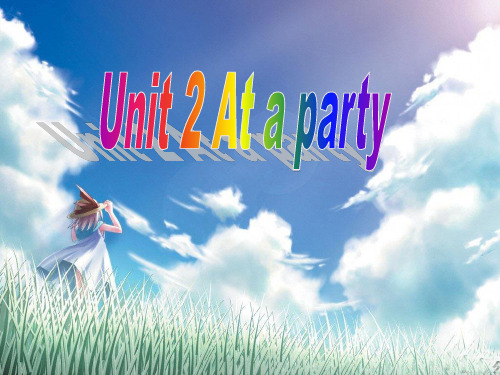
Let’s guess.
Who’s the ____ with _________?
She’s ________ .
Let’s guess.
Who’s the girl with a big head?
She’s Zhang Ye .
Let’s guess.
Who’s the ____ with ___________?
hair
头发
I’m a boy. I have short hair.
I’m a boy with short hair.
我是一个短头Biblioteka 男孩。I’m a girl. I have long hair.
I’m a girl with long hair.
我是一个长头发女孩。
eyes
眼睛
ears
He’s ________ .
Let’s guess.
Who’s the boy with short hair?
He’s Gao Hancheng .
Who’s the _____ with __________?
She’s ________ .
Who’s the woman with big eyes?
Let’s talk.
Who’s the girl with a small nose? She’s my sister.
Let’s make a dialogue. Ben: Hi, I’m Ben. I’m new here. I’m a boy with a big head. Mike: Hi, Ben. What’s that in your hand? Ben: My family photo, you can have a look. Mike: Thank you. Who’s the girl with big eyes? Ben: She’s my sister. Mike: Who’s the man with a small mouth? Ben: He’s my father. Mike: Is he a doctor ? Ben: No, he’s a teacher. Mike: Oh, I see.
牛津小学英语4Bunit7
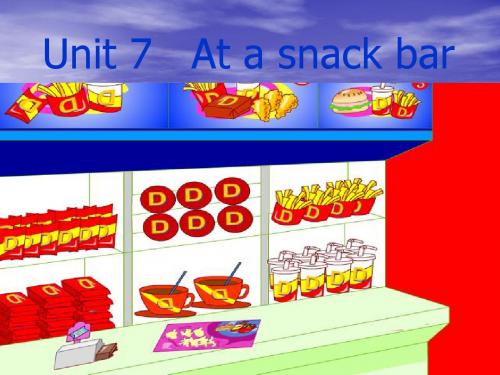
Healthy food are more and more unpopular among pupils.小学生越来越不喜欢健康食品了。 Healthy food don't include most snacks as they are high in sugar. 大都数零食都不是健康食品,因为它们含糖量高。
I don't want junk food anymore. I'd like to try some healthy food. 我再也不想吃垃圾食品了,我想吃点健康 的食物。
健康小贴士:
Eat less junk food,
少吃垃圾食品
eat more healthy food.
多吃健康食品
What would you like?
How about you? Anything else?
3. 来一些喝/吃的吗? Something to drink / eat?
如果你是顾客,想问一件商品的价格,怎么问? How much is it? 问一些商品的价格又怎么问? How much are they?
Food
a hamburger hot dog an apple pie noodles coffee
price
Food
price
3.00 7.00 5.00
10.00 Ice cream 8.00 chocolate 5.00 milk
5.00
7.00
juice tea
6.00
5.00
Questions: 1. What would Su Yang like? 2. How about Su Hai? 3. Who would like a cup of coffee? 4. How much are they? 5. What would they like in all(总共)?
典范英语4b第二课课文
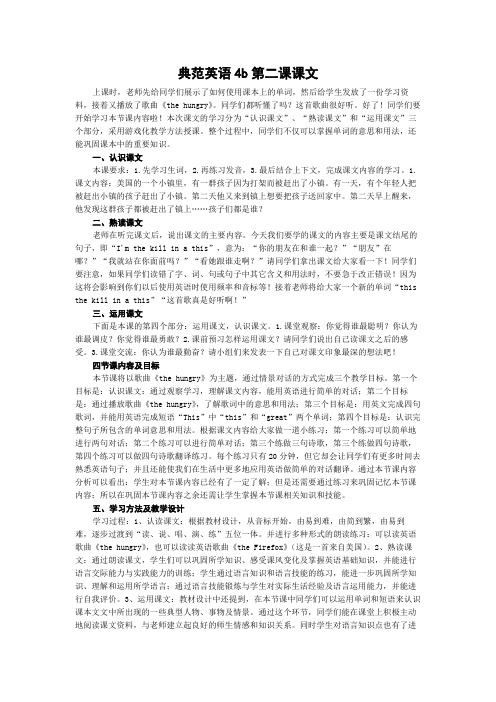
典范英语4b第二课课文上课时,老师先给同学们展示了如何使用课本上的单词,然后给学生发放了一份学习资料,接着又播放了歌曲《the hungry》。
同学们都听懂了吗?这首歌曲很好听。
好了!同学们要开始学习本节课内容啦!本次课文的学习分为“认识课文”、“熟读课文”和“运用课文”三个部分,采用游戏化教学方法授课。
整个过程中,同学们不仅可以掌握单词的意思和用法,还能巩固课本中的重要知识。
一、认识课文本课要求:1.先学习生词,2.再练习发音,3.最后结合上下文,完成课文内容的学习。
1.课文内容:美国的一个小镇里,有一群孩子因为打架而被赶出了小镇。
有一天,有个年轻人把被赶出小镇的孩子赶出了小镇。
第二天他又来到镇上想要把孩子送回家中。
第二天早上醒来,他发现这群孩子都被赶出了镇上……孩子们都是谁?二、熟读课文老师在听完课文后,说出课文的主要内容。
今天我们要学的课文的内容主要是课文结尾的句子,即“I'm the kill in a this”,意为:“你的朋友在和谁一起?”“朋友”在哪?”“我就站在你面前吗?”“看她跟谁走啊?”请同学们拿出课文给大家看一下!同学们要注意,如果同学们读错了字、词、句或句子中其它含义和用法时,不要急于改正错误!因为这将会影响到你们以后使用英语时使用频率和音标等!接着老师将给大家一个新的单词“this the kill in a this”“这首歌真是好听啊!”三、运用课文下面是本课的第四个部分:运用课文,认识课文。
1.课堂观察:你觉得谁最聪明?你认为谁最调皮?你觉得谁最勇敢?2.课前预习怎样运用课文?请同学们说出自己读课文之后的感受。
3.课堂交流:你认为谁最勤奋?请小组们来发表一下自己对课文印象最深的想法吧!四节课内容及目标本节课将以歌曲《the hungry》为主题,通过情景对话的方式完成三个教学目标。
第一个目标是:认识课文:通过观察学习,理解课文内容,能用英语进行简单的对话;第二个目标是:通过播放歌曲《the hungry》,了解歌词中的意思和用法;第三个目标是:用英文完成四句歌词,并能用英语完成短语“This”中“this”和“great”两个单词;第四个目标是:认识完整句子所包含的单词意思和用法。
牛津英语模块四课文原文
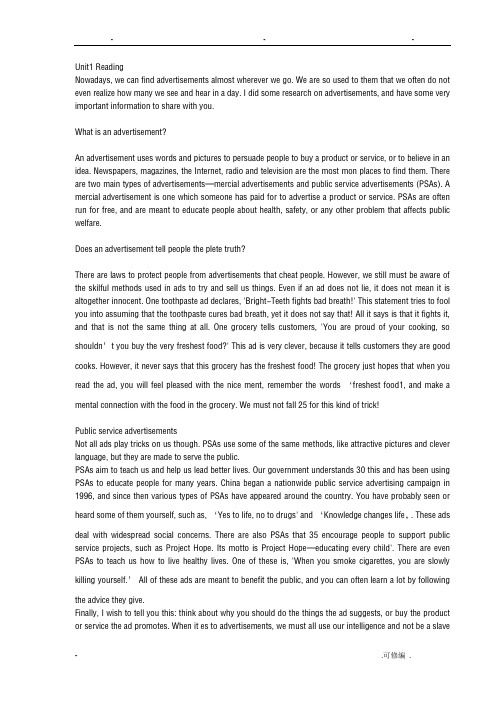
Unit1 ReadingNowadays, we can find advertisements almost wherever we go. We are so used to them that we often do not even realize how many we see and hear in a day. I did some research on advertisements, and have some very important information to share with you.What is an advertisement?An advertisement uses words and pictures to persuade people to buy a product or service, or to believe in an idea. Newspapers, magazines, the Internet, radio and television are the most mon places to find them. There are two main types of advertisements—mercial advertisements and public service advertisements (PSAs). A mercial advertisement is one which someone has paid for to advertise a product or service. PSAs are often run for free, and are meant to educate people about health, safety, or any other problem that affects public welfare.Does an advertisement tell people the plete truth?There are laws to protect people from advertisements that cheat people. However, we still must be aware of the skilful methods used in ads to try and sell us things. Even if an ad does not lie, it does not mean it is altogether innocent. One toothpaste ad declares, 'Bright-Teeth fights bad breath!' This statement tries to fool you into assuming that the toothpaste cures bad breath, yet it does not say that! All it says is that it fights it, and that is not the same thing at all. One grocery tells customers, 'You are proud of your cooking, soshouldn’t you buy the very freshest food?' This ad is very clever, because it tells customers they are good cooks. However, it never says that this grocery has the freshest food! The grocery just hopes that when you read the ad, you will feel pleased with the nice ment, remember the words ‘freshest food1, and make a mental connection with the food in the grocery. We must not fall 25 for this kind of trick!Public service advertisementsNot all ads play tricks on us though. PSAs use some of the same methods, like attractive pictures and clever language, but they are made to serve the public.PSAs aim to teach us and help us lead better lives. Our government understands 30 this and has been using PSAs to educate people for many years. China began a nationwide public service advertising campaign in 1996, and since then various types of PSAs have appeared around the country. You have probably seen orheard some of them yourself, such as, ‘Yes to life, no to drugs' and ‘Knowledge changes life,. These adsdeal with widespread social concerns. There are also PSAs that 35 encourage people to support public service projects, such as Project Hope. Its motto is Project Hope—educating every child'. There are even PSAs to teach us how to live healthy lives. One of these is, 'When you smoke cigarettes, you are slowlykilling yourself.’ All of these ads are meant to benefit the public, and you can often learn a lot by followingthe advice they give.Finally, I wish to tell you this: think about why you should do the things the ad suggests, or buy the product or service the ad promotes. When it es to advertisements, we must all use our intelligence and not be a slaveto them!Unit 1 ProjectHow do you build an ad campaign?Unlike a single advertisement, an ad campaign is a planned programme of advertisements using various kinds of ads to reach a certain audience. When you start a successful ad campaign, you must have a clear aim and an audience in mind. It is important to figure out exactly what you want to tell the audience and what you are trying to get them to do. In an ad campaign you .may need to employ different kinds of media, including posters, newspapers, magazines, radio and television.There are three major questions you must first consider:1. Who is the audience for your ad campaign?The people you want to reach are your target audience. In order to determine your audience, you will need to do a little research and analysis in advance. You will need to explore what the audience already thinks. It is very important to know your audience so you can create the right message for the right people.2. What do you want your ad campaign to say?After you have decided who your audience is, it is time to decide what you want the audience to know or think about. It is important to always try to appeal to the audience in order to get them to react in a certain way. You can gather this information from your research. When planning a public welfare campaign, you may want to ask yourself:•What does my audience already know about this problem?•What aspects of this problem would they care about or be concerned with?•Is there some history behind the problem that they would be interested in?•How does the problem personally affect their lives?3. How do you reach your audience?There are lots of different ways to get your message across when you are putting together an ad campaign. You must decide what, approach you want to use. This decision should depend mainly on your target audience and which kinds of ads reach that group best,Anti-smoking ad campaignEvery year millions of people around the world die due to smoking. Every pocket of contains poisonous chemicals that can result in lungCancer and heart disease. This costs countries a lot of money and causes great damage to the welfare of the people. There are huge numbers ofsmokers in Asia, This is why we have chosen anti-smoking as the subject of ourad campaign.The target audience is high-school teenagers. Our main aim is to discourage young people from smoking. Our research shows that young people care about their health and future. We will educate them about the bad physical effects of smoking and how smoking affects those people around them. We will explain all the advantages of not smoking, such as saving money which can then be spent on other things. Our interviews also indicate that young people are concerned about what is cool and what their friends like. We will show how smoking is not cool or attractive, because it makes people smell terrible, and gives thembad teeth, skin and fingernails. If we can convince young people not to start, they might then urge their parents and other people to give up smoking, too.Our campaign will start on 31 May, World No Tobacco Day. We will put large posters around the school with our logo and slogan. Our website will provide students with more information about smoking. We will also publish an article in the school magazine informing students about the dangers of smoking, and we will organize an essay petition as well.Our slogan: Smoking kills!Many people think that smoking is cool or enjoyable, but they are not fully aware of the damage that it does to their health. This is why we choose this picture as our logo. We want to shock people into realizing that many smokers die all too soon from illnesses and diseases related to smoking.Unit 2 ReadingThe Olympic GamesGood afternoon, students and teachers. As a member of the International Olympic mittee, I am delighted to have been invited to your school to talk to you about the history and significance of the Olympic Games. I'll share some interesting facts and stories with you, and then we'll have time for questions.Do you know when the ancient Olympic Games began? It was in the year 776 BC. They were held at Olympia in Greece every four years, for almost 12 centuries, until AD 394.Some of the sports from the ancient Olympics are still seen today, such as the long jump, wrestling and running. At the ancient Olympics, by tradition the athletes were all men and they had to pete wearing no clothes. Single women were allowed to take part in their own petition, at a separate festival in honour of Hera, the wife of the Greek god Zeus. Today, both male and female athletes from around the world can take part, no matter what nation they e from.The contemporary Olympics were first held in 1896, in Athens. It was a Frenchman, Pierre de Coubertin, who brought the Olympics back to life. He dreamt that the Olympics would make it possible for people of all countries to live side by side in peace. Now people all over the world are helping to realize this dream. Among them are many well-known athletes.Did you know that perhaps the most famous boxer of all time first came to public attention during the 1960 Rome Olympics? He won the gold medal for the USA, under his birth name Cassius Clay. Afterwards, this young man went on to win the World Heavyweight Boxing Championship in 1964 and later changed his name to the one we all know, Muhammad Ali. He returned to the Olympic Games in Atlanta in 1996 to light the Olympic flame at the opening ceremony.Another sports star I would like to mention is Michael Jordan. Everyone knows of his success in the NBA, but do you know that he helped the USA basketball team win the gold medal at the 1984 Los Angeles Olympics? Jordan also returned to the Olympics after many years, but unlike Muhammad Ali, he was still peting for medals. At the 1992 Barcelona Olympics, Jordan won his second Olympic gold medal as a member of the so-called 'Dream Team'.Chinese athletes have also made important contributions to the Olympic Games. At the 1984 Los Angeles Olympics, the People's Republic of China returned to the Olympics after 32 years' absence. I am sure the whole of China must have felt proud when Xu Haifeng won the first gold medal for his country. Deng Yaping, who won four Olympic gold medals in 1992 and 1996, is perhaps the greatest female table tennis player the world has ever seen. At the 2004 Athens Olympic Games, Liu Xiang excited people all over Asia when he became the first Asian to win the gold medal in the men's 110-metre hurdles.The Chinese led the way at the 2008 Beijing Olympics, winning 51 gold medals. For the first time in history,the Chinese women's gymnastics team won the gold medal. However, the athlete that some people remember most was Zhang Ning, a former badminton champion. At the age of 33, she was much older than the other players. Yet, she hung on to win the gold medal in the final match.These are some of the Olympic athletes who have brought joy to people across the world with their attempts to push the boundaries of human achievement. We are looking forward to seeing more of them in future Olympic Games. Join me in wishing the Olympic Movement a successful future to match its past glory. Thank you. Now, are there any questions?Unit 2 ProjectHow does a sport enter the Olympics?Entering a sport into the Olympics can be a long process. There are many requirements that must be met before a sport can be considered by the International Olympic mittee (IOC). First, a sport must have its own international association. Next, it must be practised by men in at least 75 countries on at least four continents, or practised by women in at least 40 countries and on three continents. That's not all. In order for a new sport to be added, another sport must be dropped. This helps the IOC keep the Olympics, budget under control.Which ones are out?Some sports that were part of the Olympics in the past have been removed. These include familiar sports, such as baseball, as well as more unusual sports, such as power boating. These sports were judged to have bee less popular, and had to make way for new sports which are more popular.Which ones are in?Some sports have been added, such as tae kwon do, which was first included in the Olympics in 2000. The IOC is planning to change some of the sports in the next few years. In 2016, rugby and golf, which were earlier played at the Olympics and then dropped, will be included again, as they are now very popular and are played all around the world.Which ones are still trying?Wushu is still applying to get into the Olympics. The IOC has still not approvedthe sport due to the concern about the balance of sports —there are already many other sports in the Olympics that are connected with fighting, such as tae kwon do and boxing. However, the IOC is considering changing the number and type of Olympic sports in the future, so Wushu fans may finally get what they are hoping for.Winning isn’t everythingIt was near the end of the football match, and neither team had scored. The captain of the Eagles passed the ball to a teammate, and then ran down near the Kangaroos' goal. His teammate passed the ball back to him, but the t shot was too high. The Eagles' captain knocked the ball to the ground with his hand, and then kicked it and scored. The referee blew the whistle; the match was over and the Eagles had won. Of course, the goal should not have, counted. However, now it was too late.Later, a reporter asked the Eagles' captain what had happened.'We won, and that is all that matters,' the captain said.The Kangaroos were out of the tournament, while the Eagles continued on. However, with the referees now keeping a close watch on the Eagles, they struggled and lost their next match. Afterwards, they plained that the referees had been unfair.The Eagles went home angry and bitter because they did not win the tournament. Meanwhile, the Kangarooswent home and trained harder than before.In the next tournament, the Kangaroos defeated the Eagles by a score of 5 to 1. They went on to the final match against the Bears. The match was tied \ with minutes to go. The Kangaroos' captain was near the Bears' goal. A teammate passed the ball to him, and by accident it hit his hand. The Kangaroos' captain stopped the match and let the Bears have the ball.Within minutes, the Bears scored and won.Later, a reporter asked the Kangaroos' captain what had happened.'They won,’ the captain said. ‘They were the better team,’The Kangaroos went home proud that they had done their best. Many of the Kangaroos' players became friends with the players on the Bears, team for the rest of their lives. In defeat, the Kangaroos foundsomething more precious than victory—they found friendship, honour and respect.Unit 3 ReadingNot just watching a film •••RealCine—virtual reality for everyoneThis presentation will give you some information about RealCine: how it works, why it is better than a film, and how it can be used in other ways. The RealCine experience will amaze you, and you will agree that this is an extraordinary technology that deserves to be developed further.The technology behind RealCine is virtual reality (VR). Unlike a film, where a passive audience watches and hears what is happening on a screen, RealCine puts you into the action and connects with your senses of sight, hearing, smell and touch in an active way. Imagine that a VR user 'goes' sightseeing in the Himalayas. Not only will he or she feel every step of climbing Mount Qomolangma, but the user will also experience the cold, smells, sights and sounds of the surrounding environment; he or she will enjoy a feeling of happiness and a sense of achievement upon reaching the top.RealCine works by making the users feel that they are really in a new world --- a world that does not exist except in a puter program. To achieve this, special VR headsets are designed to allow the users to see in 3-D and hear the sound all around them. The movements of the headset indicate the direction in which the user wants to go. The user also wears special gloves so he or she can 'touch' the people and objects that he or she sees. To add to the virtual world of RealCine, the headsets even have small openings that give out smells to match the environment. Both the headsets and the gloves are connected to a puter network in the VR studio.In scientific studies it has been shown that VR can be a good treatment for people who have social problems. In one case, a teenager who was afraid of talking and playing with his schoolmates was treated with VR. In the world created by RealCine, he became the captain of the Brazilian football team and scored the winning goal in a World Cup final. This encouraged him to bee more confident around others.An argument has been put forward that some users will be disappointed by RealCine because VR is not real. However, with VR we are able to do things that could never be achieved in real life. For example, with the aid of RealCine, a seventy-year-old grandfather recently took a trip to Africa. In reality, he is disabled and can nolonger walk, but he was able to see and touch a lion while still in the convenience of the VR studio. Besides this, VR can be used to practise skills in a secure environment thatotherwise would be quite dangerous. For example, firefighters could use RealCine to train safely, without the risk of getting injured in a burning building. It could be used in class as well. Teachers could bring history alive by placing students in an ancient town, or they could teach biology by allowing students to experience the world as a whale or a squirrel.Finally, RealCine provides fantastic technology for urban planning. Engineers can enter the design of a neighbourhood into a puter, and then use VR to 'walk' around the neighbourhood, see how it looks and make changes before | construction is carried out. This kind of urban planning is in the long term cheaper and more practical, pared with the way most urban planning is done today. I remend the government use the technology in the future planning of this city.Unit 3 ProjectJourney to the centre of the earthIn 1863, Professor Otto Lindenbrock found a secret message in an old book he had recently bought. The message spoke of a trip to the centre of the Earth through a volcano in Iceland. Immediately, he got his things packed and went to Iceland, forcing his nephew Axel to go with him.In Iceland, the Professor hired a guide named Hans. When the three of them reached the volcano, they journeyed underground through a small cave. After many days, they came to a vast room with a large ocean inside. On the shores of this ocean, there was a forest and huge mushrooms. High above, the sky was filled with gas that gave off light like the sun.The three men built a small boat and set sail. All of a sudden, two dinosaurs rose to the surface and began to fight each other. The small boat was almost sunk by the dinosaurs before they were able to get away.They sailed to shore and explored the forest. They came across huge insects and many strange creatures. As they were wandering around, they noticed a man sitting against a tree in the distance—he was at least fourmetres tall. The men became afraid, and ran back to the boat.They set sail again, and saw what looked like an exit, but it was blocked by rocks which had fallen down from the ceiling. They made a bomb to blow up the rocks. After the bomb exploded, their boat rushed wildly forward into a large hole. The boat floated down with the water.It was too fast for them to escape. They could only hold on to the boat in terror.Finally, they reached the bottom of the hole. Then the water began to push them up. They floated upwards for miles. The water rushed beneath them, pushing them out into the sunlight. They now found themselves in a volcano in Italytheir adventure was over, but a new one was about to begin.The Time Machineby H. G. WellsHere is my Time Machine. This is where you sit, and with these two white handles, you can travel into the future or the past.I finished the machine just last week, and decided to use it to see the future. As I pulled one handle, the world around me became foggy. Days and nights zipped by and everything changed before my eyes. Buildings and cities appeared and disappeared in a flash. Finally, I heard a loud thunder, and everything stopped. There was a city in front of me that appeared very old and worn.I was now in the year AD 802,701, and mankind had evolved into two races, the Eloi and the Morlocks. TheEloi were small and like children. They lived above the ground and spent all of their time at play. Unlike the Eloi, the Morlocks looked like white beasts. They lived underground, where they kept machines running so that the Eloi would be happy and well fed.At first, I thought that the Eloi had forced the Morlocks to do all of the work so that the Eloi could play. However, later I came to see that I had the wrong impression: the Morlocks were the real masters. They took care of the Eloi because they lived by killing and eating them. The Morlocks even tried to catch and kill me, but luckily I was able to use the Time Machine to escape.I then travelled 30 million years into the future. I was now on a beach with an ocean in front of me, but there was neither wind nor waves, and there seemed to be little life. I went still further into the future, and the sun grew larger, redder and darker, and the Earth became cold and covered in frost. Everything was still一there was no life or movement at all.As the world turned to plete darkness, I pulled the other handle, and found myself back in my house in the present day. Only three hours had passed.。
上海牛津英语小学4B(课文完整翻译)

丑小鸭 春天是温暖的。鸭妈妈做了一个窝。她下了三个蛋。 蛋儿们都在窝里。它们是绿色的,小小的。它们是鸭妈妈的宝贝。 现在窝里有四个蛋。第四个蛋是大大的,白色的。 鸭妈妈坐在窝上。蛋儿们破开了。鸭妈妈很高兴,“欧,我可爱的宝贝们!我爱你们!” 鸭妈妈看着四只小鸭子。三只小鸭子是黄色的,可爱极了。有一只鸭子又大又灰。他很难看。 鸭妈妈用小虫子喂她的宝贝们。那只大大的灰色小鸭吃掉了所有的虫子。 鸭妈妈在池塘里游泳。黄色的小鸭子们坐在她的背上。那只丑丑的小鸭子太重了,所以他跟着他们 游。 三只小鸭子经常在一起玩。他们很快乐。丑小鸭悲伤而孤独。 丑小鸭游开了。他不想和他们待在一起。 冬天真冷啊。丑小鸭进了一所房子,但是一个老妇人把他赶走了。 现在又是春天了。丑小鸭在草丛里。两只大天鹅看见了他。 “你好呀,来玩吧。”“我是一只丑小鸭。”“不!你是一只美丽的天鹅。” 丑小鸭向池塘里望去。现在他是一只天鹅了。他非常高兴。
ቤተ መጻሕፍቲ ባይዱ
牛津小学英语4B课件
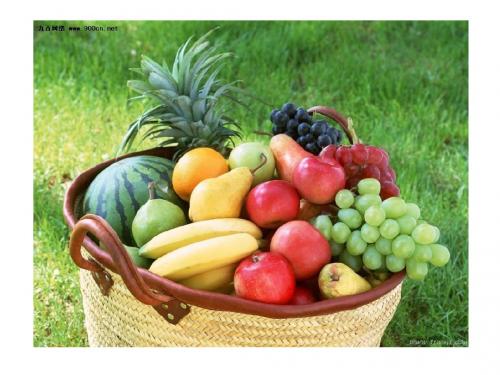
Guess: What’s this?
It’s a pear.
What are these?
They’re pears.
当我们想知道近处是一些什么东西时,可以问: ..
A: What are these?
这些
B: They’re …
Fill in the blanks.
1. This is a pear . These are pears .
2. That is a grape .
Those are grapes .
3. Miss Li wants(想要) to buy three kilos of pears. 4. Miss Li wants(想要) to buy two kilos of grapes.
those(那些)
Let’s practice
A: What are these? B: They’re …
Let’s practice
A: What are those? B: They’re …
What are these?
They’re pears.
What are those?
They’re grapes.
Read and try.
A: B: Some I help you? , please. A: How many kilos? B: ______kilo(s), please. A: Here you are. B: I’d some_____,too.
A: How ____kilos? B: ____kilos, please. A: Here you are. B:Thank you. A:Not at all. yuan, please.
牛津译林版英语四下4B-Project1-2nd
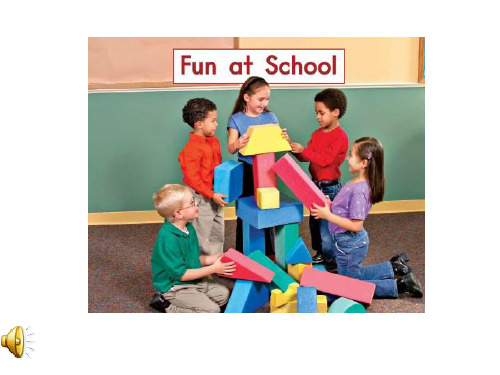
点介绍一个室场。优秀的稿件有机会被报纸 ? I ____________________________________ here. I like_____________________________________. 录用哦!相信你会比 Tom写得更棒!加油!
I ___________ my school.
Star Kids
2014.4.3
Tom将与我们竞争这次宣传学校的机会,
比一比谁说得棒,就将获得上专栏的机会!
How’s your school?
This is my school.
I can see ...
It’s...
You win!
What’s in your school?
This is my classroom. I have Chinese and English every day. I like English and PE. This is the playground.
说出小丑手中的图片。
记得要:快 !齐!响!
I _______ at school.
I _______ at school.
I _______ at school.
I _______ at school.
I _______ at school.
I _______ at school.
I _______ at school.
We make puppets at school.
We make friends at school.
My school life
(Period 2)
苏州市金阊外国语实验学校 刘 佳
Game 1 English Sliding
(沪教版小学牛津英语)4B
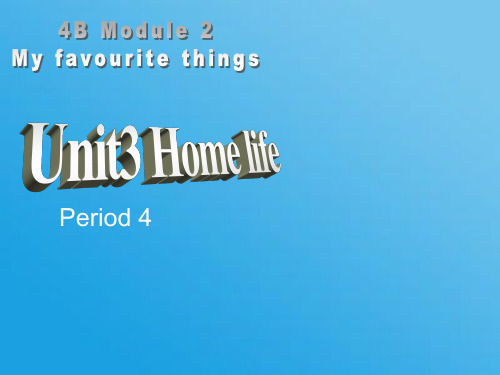
cook
have
dig
playing
running
riding
cutting
swim
wash
do
listen
cook
have
sit
playing
running
making
riding
wash cook
playing
swimming
do
listen
have
cutting
running
sit
making
boy hair path kitchen Joyce
1、直接加ing
2、去不发音的e,加ing
3、重读闭音节时, 双写最后一个辅音字母,加ing
cut make
swim
wash
do
listen
cook
have
sit
playing
running
riding
making
cut
do wash
swim listen
Kitty’s home life
It is Sunday evening. Kitty’s family is all at home. Look! Kitty is in the l_iv_i_n_g_room. She _is__d_o_in_g_her homework. Her brother, Ben likes model planes very much. Now he _is__m_a_k_i_n_g_a model plane in the bedroom. Where is Kitty’s mother? Oh, she _is_w__a_s_h_in_g_ her hair in the bathroom. It’s dinner time, Kitty’s father i_s_c_o_o_k_i_n_g_ dinner in the kitchen. Kitty’s pet is in the sitting room. It says, “Hello, hello.” How happy the home life is!
小学牛津英语上海版4B中英版
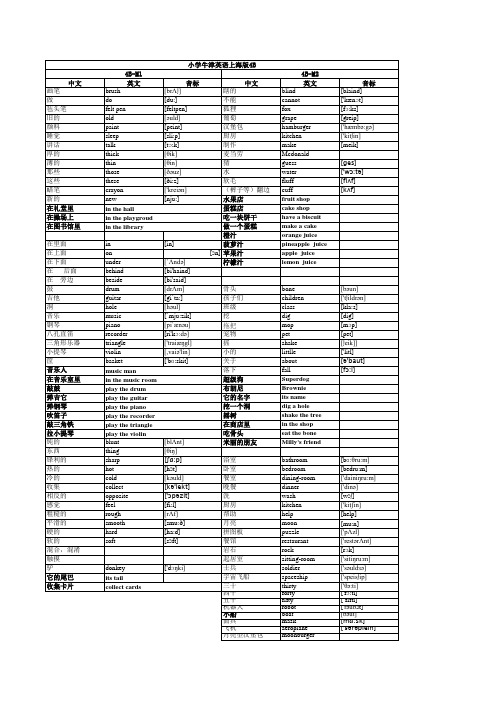
骨头 孩子们 班级 挖 拖把 宠物 摇 小的 关于 落下 超级狗 布朗尼 它的名字 挖一个洞 摇树 在商店里 吃骨头 米丽的朋友 浴室 卧室 餐室 晚餐 洗 厨房 帮助 月亮 拼图板 餐馆 岩石 起居室 士兵 宇宙飞船 三十 四十 五十 机器人 小船 面具 飞机 月亮型汉堡包
bone children class dig mop pet shake littlle about fall Superdog Brownie its name dig a hole shake the tree in the shop eat the bone Milly's friend bathroom bedroom dining-room dinner wash kitchen help moon puzzle restaurant rock sitting-room soldier spaceship thirty forty fifty robot boat mask aeroplane moonburger
4B-M3 英文 [seil] ['templ] [tכp] [bi'said] [æd] [təust] [plei'futbɔ:l] temple top beside add toast play football post office collect shells sail one's boat get up half(past) o`clock say thunder time moth late half past go to bed April August back cloudy December duckling February friday January July June live March May monday month November now October rainy Saturday September Sunday sunny swan Thursday Tuesday ugly weather Wednesday windy make a nest church 音标
典范英语4b课文lesson8原文
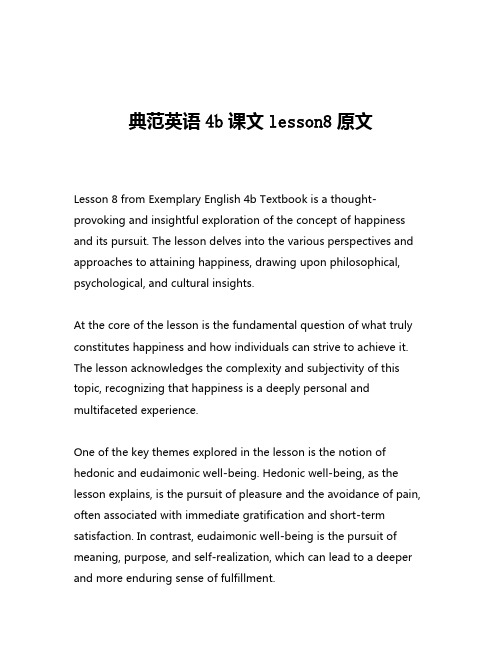
典范英语4b课文lesson8原文Lesson 8 from Exemplary English 4b Textbook is a thought-provoking and insightful exploration of the concept of happiness and its pursuit. The lesson delves into the various perspectives and approaches to attaining happiness, drawing upon philosophical, psychological, and cultural insights.At the core of the lesson is the fundamental question of what truly constitutes happiness and how individuals can strive to achieve it. The lesson acknowledges the complexity and subjectivity of this topic, recognizing that happiness is a deeply personal and multifaceted experience.One of the key themes explored in the lesson is the notion of hedonic and eudaimonic well-being. Hedonic well-being, as the lesson explains, is the pursuit of pleasure and the avoidance of pain, often associated with immediate gratification and short-term satisfaction. In contrast, eudaimonic well-being is the pursuit of meaning, purpose, and self-realization, which can lead to a deeper and more enduring sense of fulfillment.The lesson delves into the research and theories that have emerged from the field of positive psychology, which has shed light on the factors that contribute to individual and societal well-being. It examines the role of positive emotions, engagement, relationships, meaning, and accomplishment in the quest for happiness.Furthermore, the lesson explores the cultural and societal influences on the conception of happiness. It acknowledges that the understanding and pursuit of happiness can vary significantly across different societies, influenced by factors such as values, beliefs, and social norms.One of the key insights presented in the lesson is the importance of finding a balance between the pursuit of pleasure and the cultivation of meaning. It suggests that true and lasting happiness often arises from a harmonious integration of these two aspects, rather than a singular focus on either.The lesson also highlights the role of personal growth, self-awareness, and the development of emotional intelligence in the journey towards happiness. It emphasizes the significance of cultivating mindfulness, resilience, and the ability to navigate life's challenges with grace and equanimity.Additionally, the lesson explores the concept of eudaimonic well-being in depth, delving into the philosophical perspectives of Aristotle and other influential thinkers. It examines the notion of living a life of virtue, engaging in meaningful activities, and striving towards self-actualization as pathways to a deeper and more fulfilling sense of happiness.Throughout the lesson, the importance of social connections, empathy, and the cultivation of positive relationships is emphasized. The lesson underscores the profound impact that our relationships and interactions with others can have on our overall well-being and happiness.Furthermore, the lesson touches upon the role of external factors, such as socioeconomic status, health, and environmental conditions, in shaping an individual's experience of happiness. It acknowledges the complex interplay between these external factors and the internal, psychological processes that contribute to happiness.One of the key takeaways from the lesson is the recognition that happiness is not a static state, but rather a dynamic and ever-evolving process. It encourages individuals to embrace the journey of self-discovery, to continuously reflect on their values, and to cultivate the habits and practices that support their personal growth and well-being.The lesson also emphasizes the importance of self-compassion and the acceptance of the inherent ups and downs of life. It suggests that by embracing the full range of human experiences, including the challenges and setbacks, individuals can develop a more resilient and authentic approach to happiness.In conclusion, Lesson 8 from Exemplary English 4b Textbook provides a comprehensive and thought-provoking exploration of the concept of happiness. It challenges the reader to delve deeper into the complexities of this universal human pursuit, offering insights and perspectives that can inspire personal reflection and growth. The lesson serves as a valuable resource for individuals seeking to enhance their understanding of happiness and to embark on a more fulfilling and meaningful journey towards well-being.。
牛津小学英语4B(4).ppt
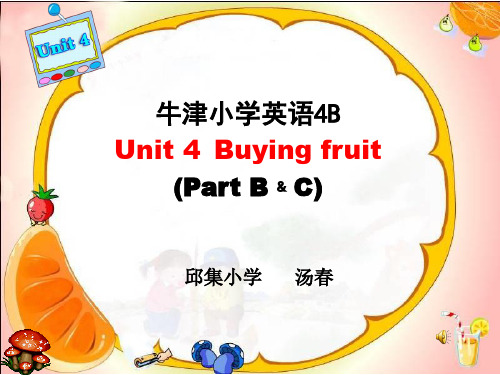
(Part B﹠C)
邱集小学 汤春
apples
O 哦 o r
oranges
oranges
bananas
peaches
pineapples
watermelons
pears
grapes
红苹果 青苹果, apple apple 是苹果 大桔子 小桔子, orange orange是桔子 黄黄的梨子是pear,梨子梨子是pear 长长的香蕉banana, 香蕉香蕉banana 芒果的名字最简单,mango mango是芒果 菠萝苹果有点像,pineapple pineapple大菠萝 孙悟空偷桃子, peach peach是桃子 八戒的肚子像西瓜, watermelon watermelon大西瓜
Pineapples pineapples 是( ) Watermelons watermelons 是( )
那些
What are those?
They’re…
pears
What are those? They’re…
oranges
What are those? They’re…
watermelons
grapes
这些
What are these?
They’re…
pears
What are these? They’re…
oranges
What are these? They’re…
watermelons
What are these? They’re…
peaches
What are these? They’re…
chant
Apples ↗ apples ↘
4B, 译林, 新版 ,全册课文
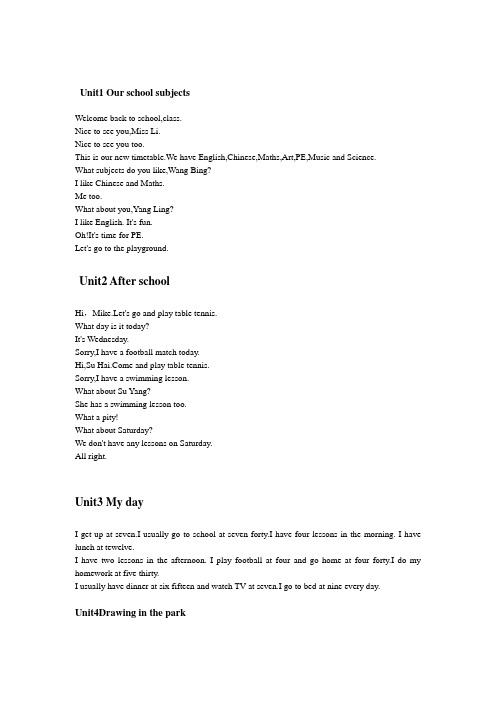
Unit1 Our school subjectsWelcome back to school,class.Nice to see you,Miss Li.Nice to see you too.This is our new timetable.We have English,Chinese,Maths,Art,PE,Music and Science.What subjects do you like,Wang Bing?I like Chinese and Maths.Me too.What about you,Yang Ling?I like English. It's fun.Oh!It's time for PE.Let's go to the playground.Unit2 After schoolHi,Mike.Let's go and play table tennis.What day is it today?It's Wednesday.Sorry,I have a football match today.Hi,Su e and play table tennis.Sorry,I have a swimming lesson.What about Su Yang?She has a swimming lesson too.What a pity!What about Saturday?We don't have any lessons on Saturday.All right.Unit3 My dayI get up at seven.I usually go to school at seven forty.I have four lessons in the morning. I have lunch at tewelve.I have two lessons in the afternoon. I play football at four and go home at four forty.I do my homework at five thirty.I usually have dinner at six fifteen and watch TV at seven.I go to bed at nine every day.Unit4Drawing in the parkLet's draw some pictures here.Good idea!What can you see over there?I can see a tree and some flowers.Can you draw them?Sure.It's easy.This is the tree and these are the flowers. Well done.Can you see the boat on the river?Yes.Can yo draw it?It’s difficult,but I can try.Is this a boat?Unit5 SeasonsIn spring, it is warm.We fly kites.We go boating.We like spring.In summer, it is hot.We eat ice creams.We go swimming.We like summer.In autumn, it is cool.We have picnics.We go climbing.We like autumn.In winter, it is cold.We make snowmen.We go skating.We like winter.Unit6 Whose dress is this?Look at my dress , Su Yang. It’s too short. Yes. Try this, Su Hai.OK.Your trousers are too long, Su Yang. Try these.All right .Now, let’s go to the party.Look at Su Yang’s gloves, Helen.They’re so big.Whose gloves are these, Su Yang?They ‘re my father’s.Whose dress is this, Helen?It’s my cosin’s.It’s so beautiful.Thank you.Unit7 what’s the matter?Come and have a pie, Taotao.Thanks, Dad, but I’m not hungry.I’m thirsty.Can I have some water, Mum?Here you are.Thank you, Mum.What’s the matter, Taotao? Are you ill?No, but I’m tired. I want to go to bed.Good night, dear.Good night, Mum and Dad.Unit8How are you?Yang Ling: Hello, this is Yang Ling speaking. May I speak to Miss Li? Miss Li: Hello, Yang Ling. This is Miss Li.Yang Ling: Hello, Miss Li. I can’t come to school today.Miss Li: what’s the matter?Yang Ling: I have a cold and a feverMiss Li: I’m sorry to hear that. Take care ,Yang Ling.Yang Ling: Thank you, Miss Li.Miss Li: Hello, Yang Ling. This is Miss Li speaking.Yang Ling: Hello, Miss Li. This is Yang Ling.Miss Li: How are you now?Yang Ling: I’m fine, thank you.Miss Li: Great. Can you come to school tomorrow?Yang Ling: Yes, I can.Miss Li: See you tomorrow, Yang Ling. Yang Ling: See you, Miss Li.。
牛津小学英语(山西版)4B
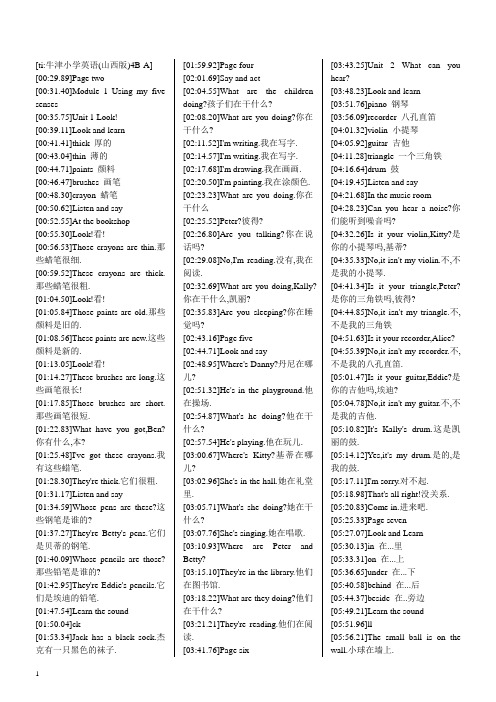
[ti:牛津小学英语(山西版)4B-A] [00:29.89]Page two[00:31.40]Module 1 Using my five senses[00:35.75]Unit 1 Look![00:39.11]Look and learn[00:41.41]thick 厚的[00:43.04]thin 薄的[00:44.71]paints 颜料[00:46.47]brushes 画笔[00:48.30]crayon 蜡笔[00:50.62]Listen and say[00:52.55]At the bookshop[00:55.30]Look!看![00:56.53]Those crayons are thin.那些蜡笔很细.[00:59.52]These crayons are thick.那些蜡笔很粗.[01:04.50]Look!看![01:05.84]Those paints are old.那些颜料是旧的.[01:08.56]These paints are new.这些颜料是新的.[01:13.05]Look!看![01:14.27]These brushes are long.这些画笔很长![01:17.85]Those brushes are short.那些画笔很短.[01:22.83]What have you got,Ben?你有什么,本?[01:25.48]I've got these crayons.我有这些蜡笔.[01:28.30]They're thick.它们很粗. [01:31.17]Listen and say[01:34.59]Whose pens are these?这些钢笔是谁的?[01:37.27]They're Betty's pens.它们是贝蒂的钢笔.[01:40.09]Whose pencils are those?那些铅笔是谁的?[01:42.95]They're Eddie's pencils.它们是埃迪的铅笔.[01:47.54]Learn the sound[01:50.04]ck[01:53.34]Jack has a black sock.杰克有一只黑色的袜子. [01:59.92]Page four[02:01.69]Say and act[02:04.55]What are the childrendoing?孩子们在干什么?[02:08.20]What are you doing?你在干什么?[02:11.52]I'm writing.我在写字.[02:14.57]I'm writing.我在写字.[02:17.68]I'm drawing.我在画画.[02:20.50]I'm painting.我在涂颜色.[02:23.23]What are you doing.你在干什么[02:25.52]Peter?彼得?[02:26.80]Are you talking?你在说话吗?[02:29.08]No,I'm reading.没有,我在阅读.[02:32.69]What are you doing,Kally?你在干什么,凯丽?[02:35.83]Are you sleeping?你在睡觉吗?[02:43.16]Page five[02:44.71]Look and say[02:48.95]Where's Danny?丹尼在哪儿?[02:51.32]He's in the playground.他在操场.[02:54.87]What's he doing?他在干什么?[02:57.54]He's playing.他在玩儿.[03:00.67]Where's Kitty?基蒂在哪儿?[03:02.96]She's in the hall.她在礼堂里.[03:05.71]What's she doing?她在干什么?[03:07.76]She's singing.她在唱歌.[03:10.93]Where are Peter andBetty?[03:15.10]They're in the library.他们在图书馆.[03:18.22]What are they doing?他们在干什么?[03:21.21]They're reading.他们在阅读.[03:41.76]Page six[03:43.25]Unit 2 What can youhear?[03:48.23]Look and learn[03:51.76]piano 钢琴[03:56.09]recorder 八孔直笛[04:01.32]violin 小提琴[04:05.92]guitar 吉他[04:11.28]triangle 一个三角铁[04:16.64]drum 鼓[04:19.45]Listen and say[04:21.68]In the music room[04:28.23]Can you hear a noise?你们能听到噪音吗?[04:32.26]Is it your violin,Kitty?是你的小提琴吗,基蒂?[04:35.33]No,it isn't my violin.不,不是我的小提琴.[04:41.34]Is it your triangle,Peter?是你的三角铁吗,彼得?[04:44.85]No,it isn't my triangle.不,不是我的三角铁[04:51.63]Is it your recorder,Alice?[04:55.39]No,it isn't my recorder.不,不是我的八孔直笛.[05:01.47]Is it your guitar,Eddie?是你的吉他吗,埃迪?[05:04.78]No,it isn't my guitar.不,不是我的吉他.[05:10.82]It's Kally's drum.这是凯丽的鼓.[05:14.12]Y es,it's my drum.是的,是我的鼓.[05:17.11]I'm sorry.对不起.[05:18.98]That's all right!没关系.[05:20.83]Come in.进来吧.[05:25.33]Page seven[05:27.07]Look and Learn[05:30.13]in 在...里[05:33.31]on 在...上[05:36.65]under 在...下[05:40.58]behind 在...后[05:44.37]beside 在..旁边[05:49.21]Learn the sound[05:51.96]ll[05:56.21]The small ball is on thewall.小球在墙上.1[06:04.41]Page eight[06:06.27]Read a story[06:08.36]The cat and the mouse [06:11.77]The cat is in the basket.猫在篮子里.[06:16.05]It is sleeping.它正在睡觉. [06:26.91]The mouse is beside the cat.老鼠在猫的旁边.[06:30.89]It is hungry .它很饿. [06:33.50]It is eating.它在吃东西. [06:40.20]The cat is behind the mouse.猫在老鼠的后面.[06:44.66]It is chasing the mouse.它在追老鼠.[06:50.26]The mouse is afraid.老鼠很害怕.[06:53.26]It is on the door.它在门上.[06:55.62]The cat is jumping.猫在跳.[06:59.48]The mouse is under the chair.老鼠在椅子下面.[07:03.09]It is running.它在跑. [07:06.14]The mouse is in the hole.老鼠在洞里.[07:09.82]It is happy.它很高兴. [07:11.56]The cat is angry and tired.猫很生气,也很累.[07:23.03]Page nine[07:25.76]Sing a song[07:27.94]The music man[07:38.64]I am the music man [07:40.44]And I can play.[07:42.55]What can you play? [07:44.80]A piano![07:47.35]Ding-ding![07:55.69]I am the music man [07:57.82]And I can play.[08:00.25]What can you play? [08:02.23]A violin![08:04.79]Zing-zing![08:13.07]I am the music man [08:15.19]And I can play.[08:17.43]What can you play? [08:19.56]A Guitar![08:22.05]Pling-pling! [08:30.52]I am the music man[08:32.67]And I can play.[08:34.80]What can you play?[08:37.31]A drum![08:39.85]Boom-boom![08:48.13]I am the music man[08:50.30]And I can play.[08:52.55]What can you play?[08:54.68]A recorder![08:57.29]Dee-dee![09:05.57]I am the music man[09:07.63]And I can play.[09:09.87]What can you play?[09:12.06]A triangle![09:14.59]Ting-ting![09:52.89]Page ten[09:54.51]Unit 3 What can you feel?[09:58.62]Look and learn[10:00.61]donkey 驴[10:03.54]tail 尾巴[10:07.02]blunt 钝的[10:09.89]sharp 尖锐的[10:14.37]Listen and say[10:18.03]This is a donkey.这是一头驴.[10:21.09]This is its tail.这是它的尾巴.[10:24.39]Can you see?你能看到吗?[10:26.01]No,I can't.不,我看不到.[10:28.88]Feel the donkey.摸一摸这头驴.[10:31.55]Put the tail on the donkey.讲尾巴放在驴身上.[10:36.97]Page eleven[10:39.09]Learn the sound[10:41.71]-ss[10:44.13]There is a glass in MissFang's classroom.[10:53.41]Page twelve[10:55.29]Read and tick[10:59.03]Danny,put your pencil inthe bag.[11:04.87]Kitty,put your balloon inthe bag.[11:11.30]Eddie,put your rubber inthe bag.[11:17.26]Alice,put your ruler in thebag.[11:23.80]Peter,put your hands inthe bag.[11:30.17]Touch one thing.[11:33.39]Feel it.[11:35.69]How does it feel?[11:39.01]It's big.[11:42.00]It's round.[11:45.23]It's smooth.[11:47.97]It's soft.[11:50.16]What is it?[11:51.84]It's a balloon.[11:54.83]Whose balloon is this?[11:57.68]It's Kitty's balloon.[12:01.92]Page thirteen[12:03.98]Read and judge[12:06.65]Where is Kitty's rabbit?[12:09.84]This is my rabbit.[12:15.88]Where's my rabbit?[12:19.29]Is it in your desk?[12:21.40]No![12:24.77]Is it under your desk?[12:27.39]No![12:29.76]Is it in this bag?[12:34.06]No,that's Peter's bag.[12:38.52]My rabbit's soft andsmooth.[12:41.84]It's white.[12:44.03]Look![12:45.16]It's on your chair.[12:47.44]Y ou're sitting on yourrabbit.[13:09.62]Page fourteen[13:11.28]Unit 4[13:13.17]What can you smell andtaste?[13:16.49]Look and say[13:19.39]It is small.它很小[13:21.64]It is rough.它很粗糙.[13:23.82]It is yellow.它是黄色的.[13:26.07]Smell it.闻一闻.[13:27.81]It is nice.好味道.[13:29.86]It is a lemon.它是一只柠檬.2[13:33.20]It is big.它很大.[13:35.21]It is smooth.它很滑[13:37.51]It is red.它是红色的[13:39.40]Smell it.闻一闻.[13:41.09]It is nice.好味道. [13:43.22]It is an apple.它是一个苹果.[13:45.29]Listen and say[13:48.73]What have you got,Kitty?你有什么,基蒂?[13:51.97]Close your eyes.闭上你的眼睛.[13:53.92]Smell it.闻一闻.[13:57.64]It's an apple.是一只苹果. [13:59.25]It's nice.很美味.[14:03.29]What have you got,Eddie?你有什么,埃迪?[14:06.29]Close your eyes.闭上你的眼睛.[14:07.97]Smell it.闻一闻.[14:11.42]It's a sandwich.是一块三明治.[14:13.64]It's nice.很美味.[14:18.19]What have you got,Peter?你有什么彼得?[14:21.17]Close your eyes.闭上你的眼睛.[14:23.92]Smell it.闻一闻.[14:27.76]It's chocolate.是巧克力. [14:29.53]It's nice.很美味.[14:34.94]What have you got,Alice?你有什么,艾里斯.[14:38.60]Close your eyes.闭上你的眼睛.[14:40.35]Smell it.闻一闻.[14:44.34]It's a cake.是一块蛋糕. [14:46.76]It's nice.很美味.[14:50.26]Page fifteen[14:51.97]Say and act[14:54.86]Ben's friend 本的朋友[14:57.91]This is David. 这是大卫. [15:00.85]He cannot see.他看不见. [15:03.53]He is blind.他是盲人. [15:05.95]He can hear.他能听见. [15:08.14]He can touch.他能触摸. [15:10.77]He can feel.他能感觉. [15:13.63]He can smell.他能闻.[15:16.35]He can taste.他能尝.[15:24.13]I can smell oranges.我能闻到橘子的味道.[15:26.85]Is this a fruit shop?这是一家水果店吗?[15:29.31]Y es,it is.是的.[15:31.90]I can smell cakes.我能闻到蛋糕的味道.[15:34.35]It this a cake shop?这是一家蛋糕店吗?[15:37.03]Y es,it is.是的.[15:39.65]I can smell hamburgers.我能闻到汉堡包的味道.[15:41.70]Is this McDonald's?这是麦当劳吗?[15:43.19]Y es,it is.是的.[15:46.25]This is a hamburger.这是一个汉堡包.[15:48.17]I can taste it.我能尝出来.[15:49.98]It's good!它很好吃![16:00.43]What can David smell?大卫能闻到什么?[16:04.25]He can smell..他能闻到...[16:10.72]Learn the sound[16:14.38]ff[16:17.57]Some fluff is on the cuff.袖口上有一些绒毛.[16:25.04]Page sixteen[16:26.52]Read a story[16:28.53]The fox and the grapes[16:31.96]Look at the grapes.[16:35.28]The grapes are round andpurple.[16:41.23]A fox is looking at thegrapes.[16:46.44]It likes grapes.[16:49.94]A bird is looking at thegrapes.[16:54.67]It likes grapes.[16:57.81]The bird is eating thegrapes.[17:03.17]They're my grapes.[17:05.58]I like grapes.[17:08.83]These grapes are sweet.[17:12.43]Those grapes are sour.[17:15.30]I don't like those grapes.[17:20.97]Page seventeen[17:23.70]Say and act[17:26.02]Birthday presents 生日礼物[17:28.37]Where is mum,Winnie?妈妈在哪儿,维尼?[17:31.13]She's in the kitchen.她在厨房里.[17:33.86]What is she doing?她在干什么?[17:36.65]She's making a cake.她在做蛋糕.[17:40.03]Whose presents are those?那些是谁的礼物?[17:43.75]They're Winnie's presents.它们是维尼的礼物.[17:45.95]Oh,yes.哦,是的.[17:47.87]It's Winnie's birthdaytoday.[17:52.35]Happy birthday!生日快乐[17:54.92]Thank you.谢谢.[17:57.22]Blow,Winnie.吹蜡烛,维尼.[17:59.64]Close your eyes,Winnie.闭上你的眼睛,维尼.[18:02.76]Put your hands in the box.[18:06.06]Touch it.触摸它.[18:08.17]Is it a toy car?是一辆玩具车吗?[18:10.54]Y es.是的.[18:12.10]Here you are.给你.[18:14.09]Close your eyes,Winnie.闭上你的眼睛,维尼.[18:16.90]Smell it.闻一闻.[18:18.06]Guess.猜.[18:19.57]What have you got?你得到了什么?[18:21.35]It's a box of chocolates.一盒巧克力.[18:23.86]Thanks,Ted.谢谢,泰德.[18:26.55]Close your eyes,Winnie.闭上你的眼睛,维尼.[18:29.10]What have I got?Listen.我带来了什么,听.[18:39.98]Oh,it's a clock!哦,是一只3闹钟![18:42.23]Thank you,Dad.谢谢你,爸爸.[18:45.54]Page eighteen[18:47.17]Say a rhyme[18:49.15]Let's play with balls.我们玩球吧.[18:51.16]Let's do it all.我们一起来玩.[18:52.78]One ball,two balls,一只球,两只球.[18:54.51]Three balls,four.三只球,四只球.[18:57.23]Five balls,six balls.五只球,六只球.[18:59.43]Seven balls,more.七只球,更多的球.[19:01.80]Eight balls,nine balls.八只球,九只球,[19:03.97]Ten balls,all!十只球,所有的球.[19:21.53]Page twenty[19:23.44]Module 2 My favourite things[19:29.76]Unit 1 My pet 第一单元我的宠物[19:33.07]Listen and say[19:35.38]Have you got a pet?你有宠物吗?[19:39.78]Have you got a pet,Peter?你有宠物吗,彼得?[19:43.35]Y es,I've got a dog.是的,我有一条狗.[19:46.16]It's my pet.这是我的宠物.[19:48.40]What colour is it?它是什么颜色的?[19:51.94]What's its name?它叫什么名字?[19:54.61]It's brown.它是棕色的. [19:57.04]Its name's Brownie.它的名字叫布朗尼.[20:00.23]Have you got a pet,Betty?你有宠物吗,贝蒂?[20:03.84]Y es,I've got a giraffe.是的,我有一只长颈鹿. [20:07.93]A giraffe!一只长颈鹿![20:10.07]It's not my pet.它不是我的宠物.[20:12.13]It's my toy.它是我的玩具.[20:17.55]Page twenty-one.[20:20.29]Learn the sound[20:23.34]sh[20:27.38]The fish is on the dish.[20:33.85]Page twenty-two[20:36.10]Play a game[20:38.34]What is my pet?[20:42.40]Some paper 一些纸[20:45.95]a pencil 一支铅笔[20:49.93]some crayons 一些蜡笔[20:53.84]1.Fold the paper 将纸折叠.[21:00.55]2.Draw your pet.画下你的宠物.[21:07.87]3.Write about your pet.写下有关你宠物的资料.[21:14.56]4.Fold the paper.将纸折叠.[21:23.05]It is samll.它很小.[21:26.04]It is brown.它是棕色的.[21:29.48]It has got short ears.它长着短短的耳朵.[21:33.74]It has got a long tail.它长着长长的尾巴.[21:38.56]It has got short hair.它有着短短的头发.[21:43.36]It is soft.它很柔软.[21:47.04]What's my pet?你的宠物是什么?[21:50.02]It's a dog.是一条狗.[21:52.08]Y es,it is.是的.[21:56.43]Page twenty-three[21:59.86]Look and read[22:01.86]Animal friends[22:05.79]I've got a fish,Min.[22:08.65]It's nice,Mog.[22:11.38]I'm hungry.[22:14.80]Superdog is digging ahole.[22:20.52]Superdog is in the hole.[22:25.90]He has a small bone.[22:29.38]Here you are,Peppy.[22:32.74]Peppy is eating the bone.[22:39.28]Milly is looking at anapple.[22:45.52]The tree is tall.[22:50.00]Ella is shaking the tree.[22:54.17]The apple is falling.[22:58.15]Milly is eating the apple.[23:02.34]Ella is eating some leaves.[23:07.75]Page twenty-four[23:09.47]Say a rhyme[23:12.67]Where,where,where is[23:17.20]My little brown dog?我的棕色小狗?[23:22.69]Is it in the shop?它在商店里吗?[23:26.74]Where,where, where is在哪里,在哪里?[23:30.54]My little brown dog?我的棕色的小狗.[23:35.08]Is it behind the mop?它在拖把后面吗?[23:40.15]Where,where,where is 在哪里,在哪里?[23:43.75]My little brown dog?我棕色的小狗在哪里?[23:48.16]Here it is in the box!它在这儿,在盒子里.[ti:牛津小学英语(山西版)-4B-B面][by:张云][00:24.84]Page twenty-five[00:27.78]Unit 2 My toys[00:31.10]Look and learn[00:34.34]21 twenty-one[00:39.64]22 twenty-two[00:45.48]23 twenty-three[00:51.15]24 twenty-four[00:56.54]25 twenty-five[01:02.32]26 twenty-six[01:07.11]27 twenty- seven[01:13.09]28 twenty-eight[01:19.05]29 twenty-nine[01:24.12]30 thirty[01:28.05]40 forty[01:31.79]50 fifty[01:35.26]Page twenty-six4[01:39.33]Learn the sound[01:42.43]sk[01:47.63]The mask is on the desk. [01:54.65]Page twenty-seven. [01:56.32]Read and judge.[01:59.97]Who is cooking dinner?谁在做饭?[02:04.49]Ben!本![02:05.92]Where are you?你在哪儿?[02:08.30]What are you doing?你在干什么?[02:10.60]I'm in my bedroom.我在卧室里.[02:12.99]I'm making an aeroplane.我在做飞机模型.[02:17.58]Kitty!基蒂![02:19.46]Where are you?你在哪儿?[02:21.90]What are you doing? 你在干什么?[02:24.24]I'm in the sitting-room.我在起居室里.[02:26.32]I'm doing a puzzle.我在拼图版.[02:30.26]Grandma!奶奶![02:32.11]Where are you?你在哪儿?[02:34.47]What are you doing?你在干什么?[02:37.13]I'm in the dining-room.我在饭厅.[02:39.62]I'm making a doll.我在做洋娃娃.[02:44.95]Where are you,Maggie?你在哪里,玛吉?[02:47.90]What are you doing?你在干什么?[02:50.17]I'm in the bathroom.我在浴室.[02:52.41]I'm washing Kitty's toys.我在洗基蒂的玩具.[02:55.61]Come and help me!快来帮我![02:59.45]Where are you,Dad?你在哪儿,爸爸? [03:01.60]What are you doing?你在干什么?[03:04.44]I'm in the kitchen.我在厨房.[03:06.89]I'm cooking dinner.我在做饭.[03:09.70]Come and help me!快来帮我![03:23.00]Page twenty-eight.[03:25.44]Read a story[03:28.08]Supergirl on the moon.月亮上的超级女孩.[03:31.28]This is my spaceship.这是我的太空船.[03:34.53]That's Superdog.那是超级狗.[03:36.89]That's his spaceship.那是它的太空船.[03:53.67]They are in theirspaceships.[03:59.67]This is the moon.这是月亮.[04:01.99]We're on the moon.我们在月亮上.[04:05.70]These are rocks.这些是岩石.[04:08.39]Those are mountains.这些是山脉[04:13.60]What's that?那是什么?[04:16.00]It's a restaurant.是一家餐馆.[04:20.08]Two moonburgers,please.请来两块月亮汉堡.[04:23.23]I like the moon.我喜欢月亮.[04:25.73]I like moonburgers.我喜欢月亮汉堡.[04:51.33]Page twenty-nine.[04:53.22]Unit 3 A busy family[04:56.37]Look and learn[04:58.61]Mr Chen 陈先生[05:00.23]Mrs Chen 陈夫人[05:01.91]Eddie 埃迪[05:03.30]Wendy 温迪[05:04.78]Tony(uncle) 托尼[05:07.13]Susan (aunt) 苏珊[05:09.71]Helen(cousin) 海伦表妹[05:12.38]Henry(cousin)亨利(表哥)[05:15.86]Listen and say[05:18.94]This is my aunt.这是我姑姑.[05:21.34]Her name's Susan.她的名字叫苏珊.[05:24.60]She's a singer.她是一名歌手.[05:26.76]She can sing.她能唱歌.[05:30.37]This is my uncle.这是我的叔叔.[05:32.91]His name's Tony.他的名字叫托尼.[05:35.87]He's a pilot.他是一名飞行员.[05:38.58]He can fly an aeroplane.他能开飞机.[05:42.44]This is my cousin.这是我的表妹.[05:45.03]Her name's Helen.她的名字是海伦.[05:47.92]She's a student.她是一名学生.[05:51.32]She can paint.她会画油画.[05:54.40]This is my cousin.这是我的表哥.[05:57.05]His name's Henry.他的名字叫亨利.[06:00.67]He's a student.他是一名学生.[06:03.66]He can draw.他会画素描.[06:07.48]Page thirty.[06:08.90]Look and read[06:11.24]The Chens 陈家人[06:14.05]Here are the Chens.这家是陈家人.[06:17.76]They are busy!他们很忙![06:21.19]Grandma is watchingtelevision[06:31.64]Mr Chen is washing thedishes.[06:37.05]Eddie is drying the dishes.5[06:51.90]Mrs Chen is reading a book.[07:03.68]Wendy is doing her homework.[07:18.35]Grandpa is writing a letter.[07:29.84]Ginger is washing her face.[07:42.69]Page thirty-one.[07:46.20]Learn the sound[07:49.65]sp[07:53.47]The wasp is on a crisp.那只黄蜂在一块薯片上.[08:00.31]Page thirty-two.[08:02.13]Read a story[08:03.47]Spiderboy[08:05.98]I like Supergirl.我喜欢超人女孩.[08:08.23]She's super!她很优秀! [08:11.14]I like Spiderboy.我喜欢蜘蛛侠.[08:13.67]He's super,too.他也很优秀.[08:20.25]He can ride a motor-bike.他会骑摩托车.[08:35.00]He can drive a car.他会开车.[08:42.36]He can fly an aeroplane.他会开飞机.[08:57.77]But he can't ride a horse.但他不会骑马.[09:11.48]Page thirty-tree[09:13.52]Say and act[09:15.40]Where's Ginger?生姜在哪儿?[09:17.82]Where's Ginger?生姜在哪儿?[09:19.81]Is she sleeping?她在睡觉吗?[09:21.58]No.没有.[09:22.81]She's not in her basket.她不在她的篮子里.[09:26.58]Is she watching television?她在看电视吗?[09:29.36]No.没有.[09:30.54]She's not in her chair.也不在她的椅子上.[09:34.68]We can find Ginger.我们能找到生姜.[09:37.47]I've got a radio我有一台无线电.[09:40.78]I've got a radio,too.我也有一台无线电.[09:43.26]We can talk.我们可以通话.[09:45.62]I can't find my cat.我找不到我的猫了.[09:48.86]What colour is it?它是什么颜色的?[09:50.63]What's its name?它叫什么名字?[09:54.24]It's brown.它是棕色的.[09:55.75]Its name's Ginger.它的名字是生姜.[09:59.11]Is that your cat?那是你的猫吗?[10:02.36]Y es.是的.[10:03.33]That's Ginger.就是生姜.[10:06.69]Hello,Wendy.你好,温迪.[10:08.25]Ginger's in a tree.生姜在树上.[10:11.30]What is she doing?她在干什么?[10:13.95]She's sleeping.她在睡觉.[10:33.41]Page thirty-five.[10:35.74]Module 3 Things aroundus[10:39.01]Unit 1 Colours and places[10:42.77]Listen and say[10:46.93]The leaves are green inspring.在春天,树叶是绿的[10:52.25]They are brown andyellow in autumn.[11:04.00]The sun is yellow in theafternoon.[11:10.10]It is red in the evening.它在傍晚是红色的.[11:17.37]The lizard is on a leaf.蜥蜴在一片树叶上.[11:21.83]It is green它是绿色的.[11:24.89]It is on a rock.它在一块岩石上.[11:27.93]It is brown.它是棕色的.[11:31.77]Page thirty-six[11:33.80]Look and read[11:36.13]The Tan family at thebeach 谭一家在沙滩上.[11:45.46]We are at the beach.我们在沙滩上.[11:49.42]The sun's shining.太阳照射着.[11:52.45]It's yellow.它是黄色的.[11:56.22]I'm swimming in the sea.我在海里游泳.[12:00.38]Jane's collecting shells onthe beach.[12:05.49]Dad's sailing his boat.爸爸在划船.[12:09.90]Mum's sitting under anumbrella.妈妈在伞下面.[12:14.54]Some boys are playingfootball.[12:26.91]Page thirty-seven[12:29.21]Look and read[12:32.41]The aeroplane is above amountain[12:37.78]The temple is at the top ofthe mountain.寺、庙.[12:43.79]The sun is behind amountain.太阳在山后.[12:48.66]The tree is near the beach.树在长椅附近.[12:53.24]The table is under the tree.桌子在树下面.[12:57.74]A leaf is on the water.叶子在水上.[13:01.86]The bench is between thetable and the tree.[13:09.27]Page thirty-eight[13:11.69]Read a story[13:13.32]The bird,the cat and thedog[13:16.98]Beside the house,there is acage.[13:24.13]In the cage,there is a bird.[13:32.91]Under the cage,there is acat.[13:39.42]Behind the cat,there is a6dog.[13:48.75]The cat is jumping.猫在跳.[13:55.29]The cage is falling.笼子在掉.[14:02.15]The bird is flying.鸟在飞. [14:05.75]The cat is chasing the bird.猫在追鸟.[14:11.14]The dog is chasing the cat.狗在追猫.[14:19.50]The bird is at the top of the tree.[14:25.95]The cat is in the tree.猫在树上.[14:31.33]The dog is under the tree.狗在树下.[14:40.33]The bird is flying.鸟在飞. [14:44.04]The cat is falling.猫在往下落.[14:47.82]The dog is running.狗在跑.[14:54.20]The bird is in the cage.鸟在笼子里.[14:59.36]Learn the sound[15:01.69]st[15:05.90]The postman is eating some toast 吐司、烤面包。
牛津小学英语4B课件

What are these?
They’re pears.
What are those?
They’re grapes.
I’d like some pears, please. How many kilos?
Three kilos.
I’d like… 我想要
I would
1. I’d like five peaches
那些
B: They’re …
Summary:
this (这个)
反 义 词 复数形式
复数形式
these(这些)
反 义 词
that(那个)
those(那些)
Let’s practice
A: What are these? B: They’re …
Let’s practice
A: What are those现方式做保护处理对用户上传分享的文档内容本身不做任何修改或编辑并不能对任何下载内容负责
牛津英语课件四年级下册 unit4
Unit4 Buying fruit
The 2nd period
(Part A H)
What’s missing?
Say a rhyme
3 遍
She’s buying fruit.
买
Look, listen and complete
What fruit does Miss Li buy? Some _______ and _______.
Look, listen and complete
1. What fruit does Miss Li buy? pears grapes Some _______ and _______.
- 1、下载文档前请自行甄别文档内容的完整性,平台不提供额外的编辑、内容补充、找答案等附加服务。
- 2、"仅部分预览"的文档,不可在线预览部分如存在完整性等问题,可反馈申请退款(可完整预览的文档不适用该条件!)。
- 3、如文档侵犯您的权益,请联系客服反馈,我们会尽快为您处理(人工客服工作时间:9:00-18:30)。
Unit1 A new studentA Read and say1.Hello, I’m Ben. I’m new here.Hello, I’m Gao Shan. Welcome to our school.2.Who’s that boy?he’s Mike. he’s a student.3.Who’s that women?She’s Miss Li. She’s a teacher.4.Excuse me,are you a teacher?No, I’m not. I’m a nurse.B Look ,read and learn1. a student2. a teacher3. a doctor4. a nurse5. a boy6. a girl7. a man8. a womanC Ask and answer--- Who’s that…?(--- He’s/She’s ××. (他/她是××。
)He’s/She’s a…(他/她是一位…)D Look and sayExcuse me,a re you a …?Yes, I am.\ No, I’m not.E Read and actMr Green: W ho’s the boy in the tree? Yang Ling:Let me see. Wow, he’s Liu Tao. Mr Green: Come down, Liu Tao.Yang Ling: All right.Mr Green: Don’t climb up the tree again. Yang Ling:Yes,sir.F listen and repeatWalkman women zebra zooThe women listens to a Walkman and looks at the zebra in the zoo.9. new(新的) 10. our(我们的)11. school(学生)12. welcome(欢迎)13. tree(树)14. climb(攀登)15. again(再;又) 16. sir(先生)17. right(正确的) 18. come down(下来) 19. excuse me(对不起,打扰一下)二、缩写词1. who’s = who is2. you’re = youare 3. he’s = he is 4. she’s = she is 5. I’m = I am 6. don’t = do notUnit2 At a partyA Read and say1.Good evening, Ben.Good evening.2. Who’s the boy with big eyes?He’s my brother.3.Is that girl your sister?Which one?The one in the white skirt.Yes, she is.4.Mum,this is my friend,Mike.Nice to meet you,Mike.Nice to meet you.B Look ,read and learnGrandfather grandmother father mother brother sisterHair a head a nose a mouth an eye an earC Ask and answerWho’s the man/… with …?(那个…(身体部位)的…(男人/…)是谁?)He’s/She’s ××/my…(他/她是××/我的…)D Look and sayIs that man/… your father/…? (那个男人/…是你爸爸/…吗?)Which one?(哪一个?)The one in the …(那个穿着…的。
Yes, he/she is.(是,他/她是的。
)/No, he/she isn’t.(不,他/她不是的。
)E Read and actMrs Black: It’s six o’clock. We’re late for the party.Nancy:Yes.Let’s hurry.Mrs Black:Where’s your brother?Nancy:He’s in the car.Mrs Black:OK. Let’s go.F listen and repeatBlack clock jacket sockHis socks,jacket and clock are blank.13. white(白色的)14. a friend(朋友)15. a skirt(短裙) 16. a party(宴会) 17.with(有) 18. which(哪一个)19. big(大的) 20. small(小的) 21. long (长的)22. short(短的)23. we(我们) 24. hurry(赶快) 25. wrong (错误的) 26. be late for(…迟到)二、缩写词1. we’re = we are2. isn’t = is not3. it’s = it is4. let’s = let us5. where’s = where isUnit3 What’s your job?A Read and say1.Hi , What’s you name?I’m Jack.2. How old are you?I’m one.3. What’s your job?I’m a waiter.4. Are they waiters,too?No, they aren’t.5.What are their jobs?They’re drivers.B Look ,read and learna policeman (policemen) a policewoman (policewomen)a waiter (waiters) a waitress (waitresses)a driver (drivers) a worker (workers)a cook (cooks) a farmer (farmers)C Ask and answer1. What’s your job?(你的职业是什么?)I’m a…(我是一位…)What’s his job?(他的职业是什么?)He’s a…(他是一位…)What’s her job?(她的职业是什么?)She’s a…(她是一位…)2. What are their jobs?(他/她们的职业是什么?)They’re…(他/她们是…)D Look ,read and completeWho’s my friend?Guess!1.Is your friend a boy? No, my friend is a girl.2.How old is she? She’s eleven.3.Are her eyes big? No,her eyes are small.4.Is her hair long? Yes,her hair is long.5.Your friend is , I think. Yes,you’re right.E Read and actYang Ling:It’s cold today,isn’t it?Su Yang:Yes.Look at that old women. Yang Ling:Which one?Su Yang:The one in the red sweater.Yang Ling:She’s my grandmother.Su Yang:How old is she?Yang Ling:Guess!Su Yang:About sixty?Yang Ling:No.She’s eighty.F listen and repeatDress driver tree trousersThe driver’s dress and trousers are in the tree.9. job(职业) 10. name(名字) 11. their(他(她/它)们的)12. today(今天)13. old(老的)14. about(大约)15. want(想要) 16. cold(冷的)17. how old(几岁)18. how many(多少)19. look at(看)二、缩写词1. aren’t = are not2. what’s = whatis 3. they’re = they areUnit4 Buying fruitA Read and say1.What are these?(这些是什么?)They’re pears.(它们是…)2. What are those?(那些是什么?)Grapes. (它们是…)3.I’d like some pears,please. (我想要一些…)How many kilos?(多少公斤?)Three kilos, please.4.I’d like some grapes, too. How many kilos?(多少公斤?)Two kilos, please.(请来…公斤。
) Here are you.(给你。
)B Look ,read and learn1. an apple (apples)(苹果)2. an orange (oranges)(桔子)3. a banana (bananas)(香蕉)4. a peach (peaches)(桃子)5. a grape (grapes)(葡萄)6. a pineapple (pineapples)(菠萝)7. a watermelon (watermelons)(西瓜)8.a pear (pears)(梨子)C Ask and answer1. What are these\ those?(这些\那些是什么?)They’re…(它们是…)D Look and sayI’d like some…, please.(我想要一些…)How many kilos?(多少公斤?)…kilo(s), please.(请来…公斤。
) Here are you.(给你。
)E Read and actA:Can I help you?B:Some apples,please.A: these or those?B:The red ones,please.A: How many kilos?B:Four kilos.A: Here are you. Eight yuan,please.F listen and repeatThin think there thoseI think those dogs over there are very thin.9. buy(买)10. some(一些) 11. fruit(水果) 12. kilo(公斤)13. or(或者) 14. yuan (元) 15.great(好极了)二、缩写词I’d = I would三、句型1. What are these?(这些是什么?)They’re…(它们是…)What are those?(那些是什么?)They’re…(它们是…)2. I’d like some…, please.(我想要一些…)How many kilos?(多少公斤?)…kilo(s), please.(请来…公斤。
